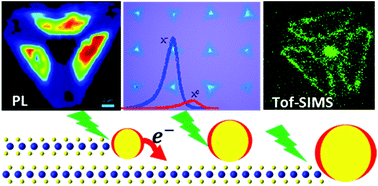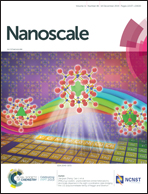Seeded-growth of WS2 atomic layers: the effect on chemical and optical properties†
Abstract
The growth of high quality materials from well-defined seeds is a well-established and beneficial procedure, as it enables the control of the crystal orientation, domain size, phase and chemical composition of nanocrystals, thin films and 3D crystals. The seeded-growth approach for 2D transition metal dichalcogenides (TMDs) is investigated, envisaging that seeds have a great impact on the chemical composition of the grown layers and thus, on their chemical and optical properties. The controlled nucleation and narrow domain size distribution of single crystalline WS2 atomic layers are demonstrated by employing the seeded-growth approach. The growth of single layer WS2 domains from well-defined Au seeds leads to nanoparticle (NP) decoration over the domain in a very peculiar way that might be related to the growth mechanism of such atomic-layers. The segmentation in Raman enhancement and photoluminescence maps of exciton and trion emissions well correlate with the presence of Au NPs observed in electron microscopy and chemical maps obtained by time-of-flight secondary ion mass spectroscopic imaging. This work emphasizes the importance of the seed material and its effect on the grown 2D material and may lead to novel methodologies for controlled growth, doping and the formation of hybrid materials to be used in catalysis, sensors and optoelectronics.



 Please wait while we load your content...
Please wait while we load your content...